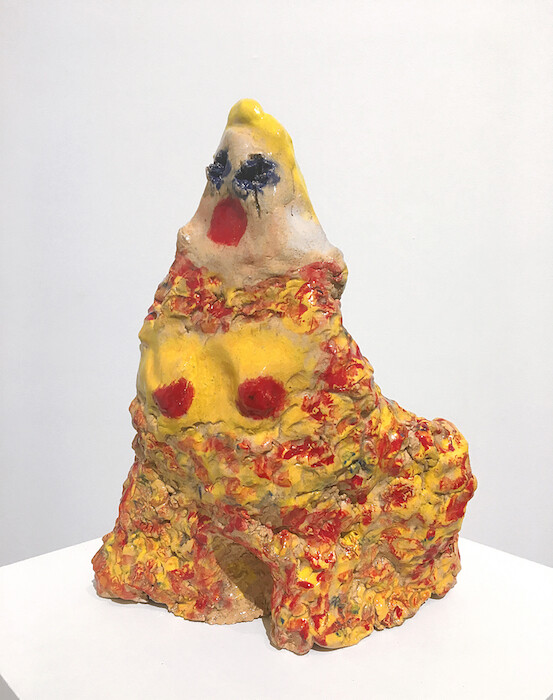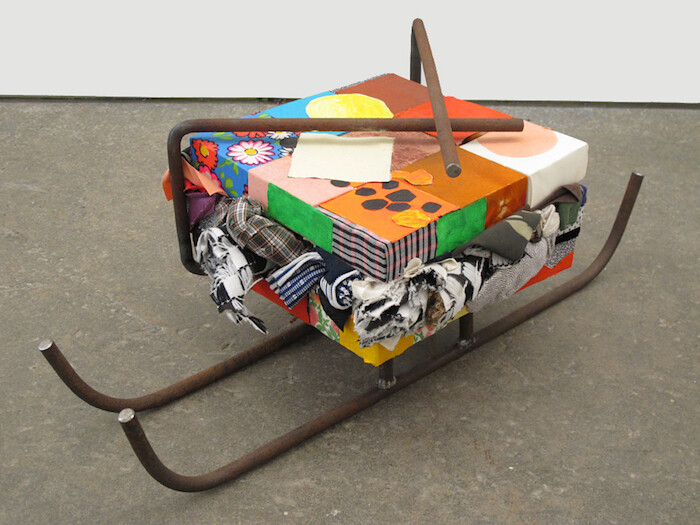If the art auction is the ultimate hunger games of ostentatious display for your taste and bank account, the art fair is the auction’s suburban or exurban cousin: the mega shopping mall, where everything is under one roof. Whether or not you went in knowing what you wanted to get and what your individual sensibility might consist of, there is a tidal flow of people and things that overwhelms and cross-wires your brain toward shutdown.
Any individual piece of art, of course, has its competitors for attention at the fair, including not only a swirling mass of people (most decked out in lively garb) but the mass of art itself, an ongoing assault not just to the eye but to the mind demanding response to an endless stream of questions, starting with “What is that?” and often ending with not only “Is it good or bad?” but “Why?” or “What is it good for?”
The Armory Show, having established itself after a mere 22 years as the go-to art fair of scale in New York, is attempting this year to buck off a sense of staidness, of predictability and unmaneuverability. Filling two of the giant piers on the Hudson River (appropriately enough, since piers have been attached to the edges of cities and civilizations through time immemorial to serve as entry zones for goods-mongering), the art fair summons its multitude of human players to convene in long pavilions, broken up into hundreds of smaller compartments containing pop-up galleries for the spectator sport of seeing what culture has wrought. Or, rather, what humans have wrought to make culture up to the present moment.
And they are not just the physical artifacts for one’s consumption, immediate or long-term—the experiential retinal candies that make one pause, wonder and then… lose any trains of thoughts on the way to stupefied appreciation of what the senses can respond to (I’m thinking here of the dozens of artworks involving mirrored materials of one kind of another that dotted the Armory). There are also, however, works that represent human concerns in sly and clever ways along with more direct confrontational engagements with the political.
At Susanne Vielmetter, Los Angeles, Pope.L’s rough and ready Black Letter Painting (2017) evokes at once the feelings of lasting endurance and almost ghostly ephemerality through a dimly stenciled palimpsest of letters and words (beginning with those of “Brown People” near the top of the canvas) underneath provisional daubs and smears of thin paint, augmented by blue painters’ tape and a lone post-it note seemingly barely held in place, as if an afterthought waiting to be finished.
The large cutout lettering of Andrea Bowers’s Resisters (2017) at Kaufmann Repetto, Milan, is made of cardboard and tiny LED lights networked in series. Through different colors flashing across the letters a double-meaning (“Re” + “sisters”) is continually highlighted. The effect from a near distance is half elegant, half gaudy. Coming closer to the piece, that effect is belied by the cheap material of cardboard from recycled commercial product packaging and the exposed wiring for the lights inside the letters. Insistent, beguiling, the piece has it both ways: as pointer to continue the struggle even where simple gestures of solidarity can feel enervated, persisting in not keeping still and not shutting up.
At Jack Shainman Gallery, New York, Brad Kahlhamer’s Eagle Butte SoDAK Famous (2016) channels a complex iconography of Native American archetypes and clichés through the painterly gestures of late-last-century East Village New York, employing oil on a painters’ tarp in sketchy yet effective fashion.
The gestures of the Native American Cheyenne River Tribe are shown by Donald Ellis in fuller force with a series of ledger drawings and two larger paintings on animal hide that form the oldest ensemble of work at the fair, dating back to the 1850s. The imagery transmitted in many of these pieces, collected and traded from indigenous peoples, documents the shifting of indigenous culture under colonialism for future generations and other peoples—via depictions, for instance, of early, hostile encounters between Native Americans and U.S. military, or in the very medium of the drawings themselves: accounting ledger books introduced by U.S. government agents starting in the middle of the nineteenth century and used by indigenous artists as a new material resource. Such an unintended outcome is all the more potent and poignant at the moment that a series of confrontations at Standing Rock over land rights and the threat of environmental degradation in the Dakotas has brought issues relating to the U.S. government’s disregarded treaties for native land back to public attention, but then was superseded yet again by onslaughts of bad-faith politics and rapid-fire modern media news cycles.
In Riot Shield: Butter (2012), at Roberts and Tilton, Los Angeles, Daniel Joseph Martinez puts in the face of the viewer words stemming from the diversionary tactics of patriotic ideology in response to charged moments such as the Cuban Missile Crisis. He does so by hand-painting letters from a semi-apocalyptic text on transparent plastic police riot shields. Martinez uses the same technique to confront viewers with the different effect of ironic beauty in Riot Shield: Cherry Blossom (2012), by sharing through his lettering the aching lines in Donald D. Walsh’s translation of Pablo Neruda’s Residence on Earth (1933–1947) representing individual figures who might be moved to revolution:
… so many people asking questions everywhere. There is the bloody blindman, and the angry one, and the disheartened one, and the wretch, the thorn tree, the bandit with envy on his back.
More than most work at the fair, imagining where these pieces might end up is a tricky game—they’re not so lively if ultimately becalmed in a museum or in a private collection for clear display but further impactful if taken off the wall and put to use, whether in offense or defense.
Meanwhile, far downtown from the Armory, the Independent Art Fair, now in its eighth year, has further institutionalized itself in the partitioned spaces of its downtown office building site (re-locating from its expansive starting point in the former DIA gallery spaces of Chelsea back in 2010), with a wide range of galleries which are there not only to share cultural inventiveness but to, well, sell work. Jaunty and packed where the Armory feels more measured and almost stately, Independent nonetheless feels like a young adult still, with moments of flash, grit, and eccentricity while overall seeming to be getting more and more grown up in its public-facing aspects.
Among highlights this year were works by a number of unschooled, self-taught, and/or older artists whose idiosyncrasies manage to cut through the clutter of the fair’s densely filled spaces. Among them, a good range of sculptures and drawings by Beverly Buchanan at Andrew Edlin, New York, coming off the just-closing high of Buchanan’s posthumous retrospective at the Brooklyn Museum. The smaller-scale moment at Independent delivers the kind of intimacy that makes sense with the type of re-creations that Buchanan dedicated her creative output toward: the smaller-scale replications of the seemingly casual, vernacular architecture of rural shacks and D.I.Y. buildings. The ramshackle nature of these reconstructions in miniature can seem slapdash and confusing, but now more than ever the sweet differences that these alternatives provide to utilitarian cookie-cutter housing and other contrived sculptural practices is winning.
Alice Mackler’s brightly colored ceramics at Kerry Schuss, New York, offer a series of lively yet distorted figures who all seem vulnerable to some greater emotion than mere paint and porcelain in bright colors should be able to manage. Details that run from sometimes ambiguous to just readable add to the sense that the sculptures’ arrested poses morph in front of one’s eyes.
Better known now but still startling in their evocations, Nancy Shaver’s series of intricate combos of repurposed objets at New York’s Derek Eller loom in their small way like obsessively rearranged playthings that have the ineffable presence of a story half-told. Custom-made and colored blocks, rusted rebar bent to resemble sled runners, holders and footing for sculptures of commercial fabrics, partially folded but also wadded up and arrayed in patchwork create small tableaux with dark auras creeping out along the edges of the combined elements. Viewing each one is like being a stranger-guest sifting through the Christmas packages in somebody else’s home in another country.
The department store ethos of Independent and the Armory doesn’t always do the best service delivering the goods in the subtlest of settings. Nevertheless, the large-scale presence of so many thoughtful and striking moments—and the hordes of not only culturally curious buyers but culturally savvy viewers—goes beyond what would ever be likely to crowd into even the most mega of gallery spaces otherwise. It continues to give a reason for being for the hyperbolic gatherings of stuff and people: culture itself and the political and social spaces it can clear out even in the midst of much over-excited clutter.









